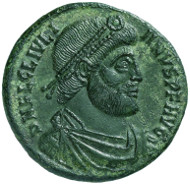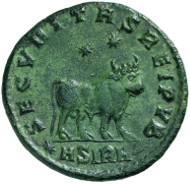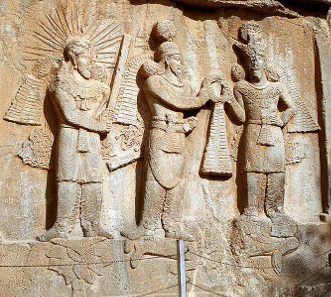Human Faces Part 19: The Saint of the Heathens
with the kind permission of the MoneyMuseum, Zurich
Why is it that for centuries – or rather thousands of years – the head has served as the motif for the side of a coin? And why has this changed in the last 200 years? Ursula Kampmann poses these questions in her book ‘MenschenGesichter,’ from which the texts for our new series are taken.
Roman Imperial Times. Julian II, nicknamed Apostate (Lat. he who has abandoned religion), (360-363). Bronze coin, Sirmium, 361. Pearl-diademed, draped and cuirassed bust of Julian r. Rev. Bull standing r., two stars above. © MoneyMuseum, Zurich.
Julian had anything but an easy childhood and adolescence. When was only five years of age, he escaped the bloodbath that killed nearly all of his relatives. Christian teachers, appointed by the emperor, educated the juvenile, secluded from the world. Julian got himself a little bit of freedom at the age of 19. He used it to study with the most renowned philosophers of his day. It will come as no surprise that Julian considered Christianity a symbol for imprisonment and philosophy a lesson of liberty.
It was a logical consequence that Julian tried to turn back the hands of time when he surprisingly rose to absolute rule. No, he didn’t prosecute the Christians but intended to establish true religion equality. The Christian church leaders, however, being spoilt by success, deemed that prosecution already. After all, Julian insisted on the possessions, they had acquired thanks to their position of strength, being surrendered. In addition, Julian established a national control on teachers on the grounds that those who didn’t believe in the old gods weren’t suited to teach old believers. Even though the successors of Julian – all staunch Christians, needless to say – annulled nearly all decisions of their predecessor, this edict wasn’t abolished. It became a useful tool for the authorities to exert influence on the education of future generations.
Julian, on the other hand, wasn’t satisfied with oppressing the Christians. He wanted to oppose their ideals with a morally strengthened paganism and served as role model himself: sobriety in moral conduct – the imperial ceremonial was reduced to a tenth-rate minimum –, continence – for conscience’s sake, Julian didn’t beget any children –, and munificence towards the gods – his contemporaries mocked at Julian because of the herds of bulls that sighed out their soul at the altars of Jupiter. In short, Julian was an emperor his people couldn’t understand.
Investiture relief of Ardashir II from Taq-e-Bostan from 379. At the feet of the king (center) a bearded figure is lying, clad in Roman garments and wearing a diadem. That figure is identified with Julian who died in a battle against the Persians. Photograph: Philippe Chavin / http://creativecommons.org/licenses/by-sa/3.0/deed.en
The intellectuals, who were trained in philosophy, rejoiced –, but only until a stray arrow unexpectedly put an end to Julian’s life in 363. His successors hastened to reinstate Christianity into its former rank. That dashed many soaring hopes. The admirers of Julian were left with collecting and preserving every scrap of tradition to the effect that from all ancient emperors, we know him best, that ‘Apostate’.
In the next episode, we will tell about the fate of Galla Placidia, an empress who, despite many setbacks, prevailed in her days that were dominated by men.
All sections of the series can be found here.
The book ‘MenschenGesichter’ is available in printed form from the Conzett Verlag website. It soon will be translated to English …











